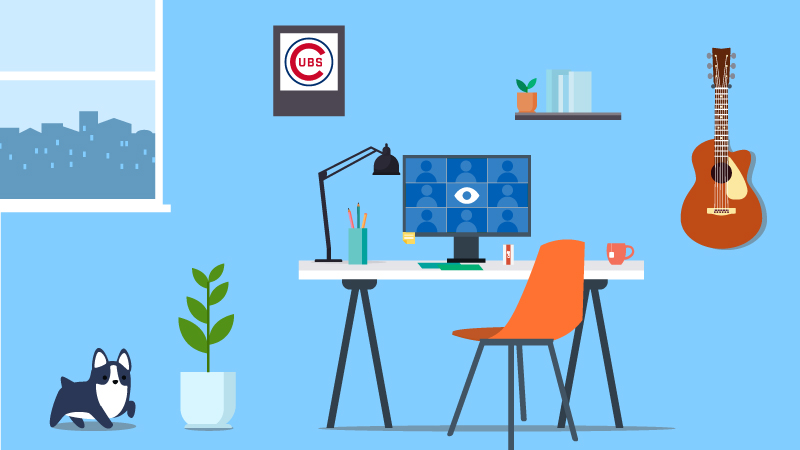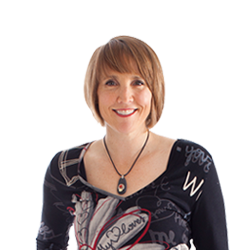Creating and Collaborating In Isolation

WANT TO SEE MORE LIKE THIS?
Sign up to receive an alert for our latest articles on design and stuff that makes you go "Hmmm?"
Our design team adjusts from a creative environment to remote work.
Showing up for work armed with creativity every day is a challenge. But collaborating without the normal tools and environment is even harder. Our entire team has been working remote for more than six weeks now. We checked in with our designers to see how they’re coping. We asked how they have adjusted, and what has or hasn’t affected their creativity.
What’s the best part about working remote?
Ricardo: My cat is always by my side, and the record player is usually on.
Angela: It’s helped in some ways with work-life balance. I’m more comfortable taking a break if I’m stuck because I can easily come back to it. I used to think a hallmark of “good” work-life balance is not taking work home.
Holly: I enjoy the freedom to set my own schedule. I commute on Metra, which means I’m beholden to the train times. Working remote I can take breaks when needed and without worrying that I won’t accomplish all the work that needs to get done before the 5:43 from Evanston.
Editor’s note: Interesting that no one commented on not having to get dressed or pack a lunch. (As I type this, I’m tallying 47 days in a row wearing joggers or tights).
Before COVID-19, the idea of working from home sounded pretty cushy. Now that you’ve experienced it at length, what do you dislike most about working in isolation?
Holly: When I bought my desk, I opted for the cute mid-century chair over the clunky ergonomic one. This was a mistake (my back aches).
Ricardo: I miss face-to-face conversations with our clients, as well as our collaborating whiteboard sessions (or doodles). Don’t forget the wonderful exposure to new music I would have every day at the office. I also really miss having a more stable routine. The lack of commuting makes it difficult for me to stick to a regular work schedule. I find myself working odd hours on more challenging days.
Angela: Technology. It’s great until it doesn’t work.
How has working from home 100% of the time affected your creativity?
Jen: As a team leader, I am looking for ways to stay engaged with the team and shake things up. Remote one-on-ones are more casual and frequent, even if by Slack. Sometimes it’s a matter of trying to find levity in the day with some jokes. Sharing design inspiration or spending time to catch up as a team about our lives are important. I follow one of my favorite authors Simon Sinek for leadership tips to get me going. I spent a week wearing silly hats to our daily standup. Recently I moved onto sharing a vintage vinyl design of the day pulling from a stack next to me.
Ricardo: I’ve felt my creativity changed in both good and bad ways. It can be harder to brainstorm together and share quick sketches. The lack of impromptu feedback made us stronger collaborators by finding digital tools to mitigate those challenges.
Holly: Remote work has been great for my creativity. There’s something about being in my own space that makes me feel more free to explore offbeat or out-there ideas. I’ve also curated my workspace to maximize concentration, which means I’m able to do more deep work. Group creativity, like collaborating and concepting, has been more challenging. But we’re getting the hang of it. There are so many great tools to facilitate idea sharing that working remote hasn’t been a barrier.
What has been the most challenging aspect of adjusting to working from home?
Angela: Quick feedback. I’m used to turning my chair or walking over to someone’s desk to talk through an idea or rough layout. Now I need to develop my work a touch more before asking for opinions, while still collaborating with the team.
Jen: When we brainstorm in a room together, the energy influences our team. Ideas roll into one another with a strong ebb and flow. We are working more iteratively and checking in sooner when working on conceptual ideas since we don’t have the luxury of impromptu sessions or walking past someone’s desk to say “Cool!”. Mind map sessions went digital using Miro. UX wireframing with Invision Freehand keeps the natural speed going. There is something special about more tangible tools, but these are useful to get the job done.
What do you miss most about working in our collaborative physical environment?
Ricardo: Just about everything. The lightness and openness of the office space. Day-long music commentary and subtle (and not so subtle) jokes coming from our office comedians (you know who you are). Massive whiteboards where we can sketch together. Don’t forget the cozy afternoon kitchen time. But most of all, being remote I miss being with my Glantz crew.
Angela: The team, office music, commentary, jokes, sense of community and spontaneous conversations. Some are distractions, but it’s much more nourishing, educational, and interesting compared to my phone, for example.
Holly: I miss my team. We do see each other on Zoom every morning, but it’s not quite the same. I’m looking forward to our first morning standup back in the office—and the studio happy hour at the end of that week. Collaborating and camaraderie is just more fun in person.
Jen: When I interview candidates looking to join the team, the most common question is Why Glantz? The answer is always the same. The people. In this case, the answer is and will forever be the people. I keep a Gratitude Journal, and at the end of the evening write down three things that I am grateful for from the day. If you got a peek at it, you would see that I have “The Team” written many, many times. And my husband. And Reese’s Peanut Butter Cups. And Health (can’t forget health). But the team is a repeat write in!

We’ve adapted to remote work, not necessarily adopted.
Our design team isn’t alone in missing collaborating and the camaraderie. Or the carefully curated office space (and ergo chairs), and excellent daily musical inspiration. It’s safe to say we’ve all adapted to the new normal of Zoom, the lack of work-life boundaries, and self-reliance. But my guess is that if given the choice, it’s not a long-term lifestyle we’d all choose to adopt.


